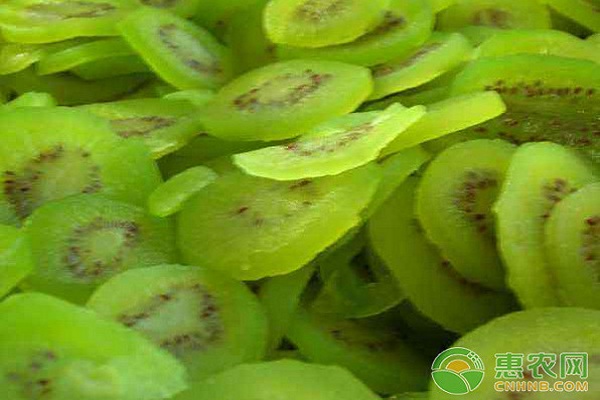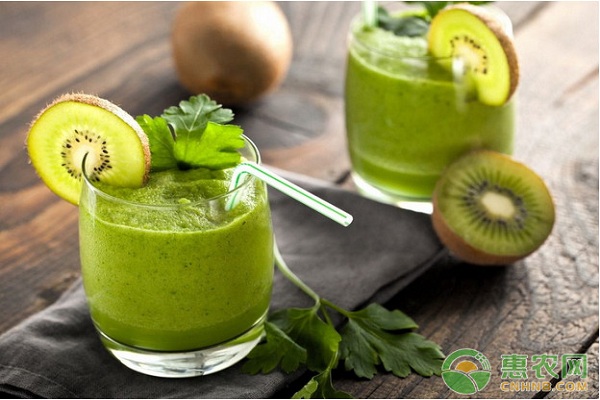What is the current status of kiwifruit processing and its prospects? The deep processing technology of kiwifruit can bring evangelism to kiwifruit growers caused by various factors. Only by using these deep processing techniques can it be possible to find more new markets for kiwifruit!

First, kiwi juice
Process flow:
Raw material pretreatment → Juice extraction → Coarse filtration → Blending → Rubber grinding → Homogenization → Vacuum degassing → Ultra high temperature instantaneous sterilization → Filling → Vacuum sealing → Spray continuous sterilization → Vacuum testing → Labeling code → Finished product
Technical points:
Raw material selection: fruit maturity of more than 80%, soluble solid content ≥ 8%, fruit flavor is normal, no diseased fruit Huer rotten fruit.
Cleaning and peeling: first disinfect with 1% bleach solution or 0.1% potassium permanganate solution to remove eggs and microorganisms, wash them with water several times, and then peel them.
Break the juice: Put the peeled fruit in a crusher or beater to beat. The fruit that has been crushed into pulp is heated to 60-65 ° C and placed in a juicer to extract juice, and an appropriate amount of pectin-degrading enzyme can be added to increase the juice yield.
Filtration: Filter with a filter or a flat cloth, and filter out the residue or pulp from the juice. At this time, the juice is turbid, and the lower layer is chilled to absorb the upper clarified juice. If you need to make turbid juice, you can vacuum degas, keep the color unchanged, and then homogenize with a high pressure machine to make pectin and juice.
Blending: 40% of the original juice plus white sugar to form a soluble solids of more than 35% of the juice.
Heating canning: The prepared juice is heated by a sterilizer. When the temperature of the juice reaches 70~80 °C, it can be quickly filled.
Sealing the can: Seal the cans with heat and the vacuum should reach 46.7kPa or more.
Sterilization and cooling: Sterilize immediately after filling the can for 8 to 15 minutes, and then cool to 40 °C after sterilization.
Wipe the cans into the warehouse: After cooling, clean the cans into the warehouse.
Second, kiwi fruit wine
Process flow:
Fruit Selection → Cleaning, Disinfection → Crushing → Main Fermentation → Press Separation → Post Fermentation → Aged → Blending → Filtration → Bottling → Finished Product
Technical points:
Raw material selection: Fully mature, soft and kiwi fruit, remove the decay, disease, fruit and unripe fruit.
Cleaning and disinfecting: Wash off the sediment, eggs and other impurities on the fruit with water. After disinfection.
Broken: The fruit is placed in a pulverizer and broken into a paste or paste.
Main fermentation: Pour the crushed fruit pulp or paste-like fruit into the sterilized fermentation tank, add 5% of the wine mother liquor solution, stir evenly, and maintain the fermentation temperature at 25~28 °C. Stir twice a day and press to separate the residual sugar to 1%.
Pressing: After the main fermentation is completed, pressing is carried out to separate the skin residue from the liquor.
Post-fermentation: After entering the fermentation, when the alcohol content reaches 12°, add the appropriate amount of sugar, and post-fermentation at 20~25°C for about 30 days, then transfer to the aged.
Aged: The new wine after fermentation needs to be aged for 1-2 years, and can be aged at 15~18 °C at room temperature.
Mixing and filtering: Mix the wine at 12~16°, and the filtered liquor should be transparent.
Third, kiwi fruit
Process flow:
Raw material selection→cleaning→peeling→slicing→hot blanching→sugar staining→sugaring→drying→shaping→packaging
Technical points:
Raw material selection: Choose 85% mature fruit, have a certain hardness, no pests and diseases, mildew and deterioration.
Cleaning and peeling: It can be cleaned by running tap water. It is peeled with 80~90% concentrated alkali solution for 30~60s, then rinsed quickly with tap water and soaked with 1% hydrochloric acid solution to neutralize the residual solution. Or artificial peeling.
Sectioning: The kiwi fruit was cut into thin slices of 5-6 mm in thickness, and the disease was immersed in 1-2% saline to inhibit the activity of oxidase.
Blanching: The sheet is blanched in boiling water for about 2 minutes and quickly cooled with tap water.
Candied fruit: After draining the water, use white sugar candy for 20~24 hours, and the amount of sugar is 40% of the weight of kiwifruit. The distribution ratio of granulated sugar in the upper middle layer is 5:3:2.
Candied: Remove the kiwi slices and drain the sugar solution. Add sugar to the sugar solution and adjust the sugar content to about 65%. After boiling, add the kiwi slices and boil for another 25 to 30 minutes. When the concentration of the sugar solution reaches 70 to 75%, the fruit pieces are taken out and drained.
Drying: Spread the sugar-dried fruit pieces in a drying room at 55 ° C for about 24 hours.
Plastic packaging: The dried fruit pieces need to be flattened and then wrapped in cellophane or polyethylene film.
Fourth, kiwi preserves
Process flow:
Raw material selection → peeling → cleaning → cut in half, digging fruit heart → heating sugar stains → drying → finished product
Technical points:
Ingredients: Choose mature and intact fruits, and remove the damaged rot and fruit.
Peeling: The selected fruit is boiled and peeled in about 10% sodium hydroxide.
Cleaning: Wash away the residue and lye remaining on the surface of the fruit with water, and rinse it 2 to 3 times with water.
Cut half of the heart: Cut the fruit longitudinally in half with a stainless steel knife to remove the heart and seeds.
Heating the syrup: Put the fruit embryo into a stainless steel double-layer pot, add 6~15% honey and a small amount of spice to the pot, heat it twice, cool and air dry.

Five, kiwi jam
Process flow:
Fruit Selection → Cleaning, Disinfection → Peeling → Crushing → Softening → Sugar Concentration → Canning and Sealing → Sterilization → Cooling → Wiping the Tanks → Packaging → Storage and Transportation
Technical points:
Raw material selection: The fruit requires less fruit, less seeds, and is rich in pectin and organic acids. It is necessary to eliminate rotten fruit, hard fruit and over-ripened fruit.
Cleaning: first disinfect with 1% bleach solution or 0.1% potassium permanganate solution, then rinse thoroughly with water.
Peeling: Refer to the peeling method of the juice making process.
Softening: After pulping or crushing the peeled fruit, make seed or seed selection according to the sieve plate of the beater, then pour into the sandwich pot and add 75% syrup to soften (10~15 minutes). Made into a whole muddy jam.
Concentrated cans: including atmospheric concentration and vacuum concentration. After concentration, the can is hot-filled and sealed when the temperature of the sauce is not lower than 86.5 °C.
Sterilization and cooling: After sealing the glass bottle, it should be sterilized immediately at 100 °C for 20 minutes, and cooled in stages to prevent the glass bottle from bursting.
Wipe the can
Six, kiwi crystal
Process flow:
Fruit Selection → Cleaning, Disinfection → Crushing → Juice Extraction → Concentration → Mixing of ingredients → Molding → Finished packaging
Technical points:
Raw material sorting: kiwi fruit with fresh and juicy, high vitamin C content and mature ingredients. Remove the fruits of green, pests and wounds.
Cleaning: Wash the surface dirt with running water.
Broken: Quickly crush with a crusher to prevent the juice from coming into contact with the air for too long.
Juice extraction: Put the broken fruit into the press and pressurize slowly, the juice will slowly flow out. The juice is coarsely filtered with gauze.
Concentration: Concentration at atmospheric pressure can be concentrated in a stainless steel double-layer pan to maintain a vapor pressure of 245 kPa. During the concentration process, the mixture should be continuously stirred and controlled for a time not exceeding 40 minutes. The pan is baked when the juice is concentrated to 60% of the soluble solids.
Mixing ingredients: The white sugar that has been dried in white is pulverized by a pulverizer and sieved into powder. Take a portion of kiwi juice and mix with 6 to 7 servings of sugar and mix well.
Molding: Generally, a pellet molding machine is used. The vibration is a loose powder and is sieved through a sieve having a certain pore size.
Finished packaging: The dried product was cooled to 40 ° C and sieved with a sieve of 3.04 mm and 1.63 mm. Remove large agglomerated granules and powder and pack in a plastic bag or iron.
Baking: The formed granules are spread and baked at 65 ° C for 3 h, and the thickness of the granules is 1.5 to 2.0 cm. Vacuum drying can also be used.
Seven, kiwi jelly
Process flow:
Fruit selection → Cleaning, disinfection → Peeling → Crushing → Beating → Concentration → Core material preparation → Leather material preparation → Washing tray formation → Condensation and dicing → Dry packaging
Eight, kiwi soda
Process flow:
Raw material selection → Cleaning → Crushing → Juice pressing → Purification → Homogenization → Sterilization → Disposal of juice syrup → Preparation of carbonated water → Bottle capping → Inspection → Labeling → Finished product
Nine, Guowangsu capsule processing technology
Process flow:
Kiwi seed → pulverization → supercritical CO2 extraction → separation → gelation → pelleting → hardening → washing pills → drying → inspection pills → finished product inspection → internal and external packaging → warehousing
Ten, kiwi fruit seed biscuits
Process flow:
Water, plant shortening, white sugar melting → filtration → cooling → leavening agent, salt dissolution → pour fruit seed powder, wheat flour premix → powder adjustment → standing → roll printing → baking → cooling loss
Send → Finishing, packaging → Inspection, storage
The process of kiwifruit deep processing technology is introduced to you. The kiwifruit growers who need it can learn to expand their sales and improve their economic interests!
Check Valve,Nrv Union Type,Stainless Steel Union Type Nrv,Stainless Steel Nrv
Wenzhou Gaoya Light Industry Machinery Co.,ltd. , https://www.hongyafitting.com
